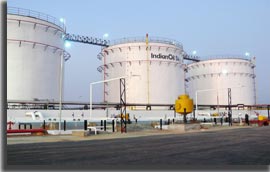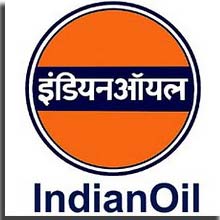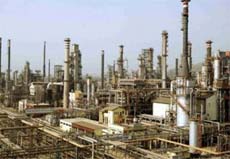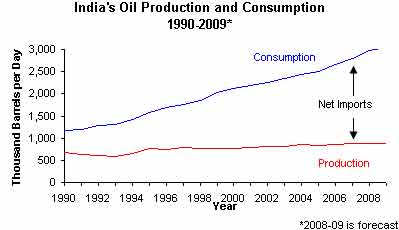| Size of the Industry | India today has total reserves of 775 million metric tonnes (MMT) of crude oil and 1074 billion cubic metres |
| Geographical distribution | Assam, Rajasthan, Mumbai, Vishakhapatnam, Chennai, Nagapatinam, Kochi, Bongaigaon, Numaligarh, Mangalore, Tatipaka |
| Output per annum | India produced roughly 880 thousand barrels per day (bbl/d) of total oil in 2009 from over 3,600 operating oil wells |
| Percentage in world market | India has approximately 5.6 billion barrels of proven oil reserves as of January 2010, the second-largest amount in the Asia-Pacific region after China. |

In 1955, ONGC was formed as a Directorate and then in 1956 became a Commission. Indian Refineries Ltd, a government company was set up in 1958. Later In 1959, for marketing of petroleum products, the government set up another company called Indian Refineries Ltd. Then in 1964, Indian Refineries Ltd was merged with Indian Oil Company Ltd. to form Indian Oil Corporation Ltd.
During 1960's, a number of oil and gas-bearing companies were discovered by ONGC in Gujarat and Assam. Discovery of oil in February 1974 of significant quantities in Bombay High opened up new avenues of oil exploration in offshore areas. During 1970's and till mid 1980's exploratory efforts were made by ONGC and OIL India to yield discoveries of oil and gas in a number of structures in Bassein, Tapti, Krishna-Godavari-Cauvery basins, Cachar (Assam), Nagaland, and Tripura. In the year 1984-85, India achieved a self-sufficiency level of 70% in petroleum products. Gas Authority of India Ltd. (GAIL) was set up in the year 1984 to look after transportation, processing and marketing of natural gas and natural gas liquids. GAIL has been successful in the laying 1700 km-long gas pipeline (HBJ pipeline) from Hazira in Gujarat to Jagdishpur in Uttar Pradesh, passing through Rajasthan and Madhya Pradesh.

Today to meet its growing petroleum demand, India is investing heavily in oil fields abroad. India's state-owned oil firms have stakes in oil and gas fields in Russia, Sudan, Iraq, Libya, Egypt, Qatar, Ivory Coast, Australia, Vietnam and Myanmar. Indian Oil and Gas Industry has a vital role to play in India's energy security and if India has to sustain its high economic growth rate.
The Oil that is produced by the Oil Industry in India provides more than 35% of the energy that is primarily consumed by the people of India. This amount is expected to grow further with both economic and overall growth in terms of production as well as percentage. The demand for oil is predicted to go higher and higher with every passing decade and is expected to reach an amount of nearly 250 million metric ton by the year 2024.

NELP framework is the primary mechanism through which the Indian government has promoted new E&P projects. The latest round of auctions, NELP VIII, was launched in April 2009 and attracted nearly $1.1 billion in investment.
According to Oil & Gas Journal (OGJ), India has approximately 5.6 billion barrels of proven oil reserves as of January 2010, the second-largest amount in the Asia-Pacific region after China. India's crude oil reserves tend to be light and sweet, with specific gravity varying from 38° API in the offshore Mumbai High field to 32° API at other onshore basins. India produced roughly 880 thousand barrels per day (bbl/d) of total oil in 2009 from over 3,600 operating oil wells. Approximately their are 680 thousand bbl/d was crude oil; the remainder was other liquids and refinery gain. In 2009, India consumed nearly 3 million bbl/d, making it the fourth largest consumer of oil in the world. EIA expects and predicts approximately 100 thousand bbl/d annual consumption growth through 2011.
|
In January 2010, Gas Authority of India Ltd (GAIL) said that gas availability in India is expected to grow at 23% compounded annual growth rate (CAGR) to 312 mscmd by 2013-14, buoyed by trebling of domestic production to 254 mscmd and doubling of regasified liquefied natural gas imports to 58 mscmd.
|

|
Today, there are about total of 18 refineries in the country comprising 17 in the Public Sector, one in the private sector. There are 17 Public sector refineries are located at Guwahati, Barauni, Haldia, Mathura, Digboi, Koyali, Panipat, Vishakapatnam, Chennai, Nagapatinam, Kochi, Bongaigaon, Numaligarh, Mangalore, Tatipaka, and two refineries in Mumbai. The private sector refinery built by Reliance Petroleum Ltd is in Jamnagar is the biggest oil refinery in Asia.
- Indian Oil Corporation
- ONGC
- Bharat Petroleum
- Reliance Petroleum Limited
- Essar Oil Limited
- Gas Authority of India
- Hindustan Petroleum Corporation
- Aban
- Oil India Limited
- Tata Petrodyne
- To support India's energy security the country is constructing a strategic petroleum reserve (SPR).
- The first storage facility at Visakhapatnam will hold approximately 9.8 million bbls of crude (1.33 million tons) and is scheduled for completion by the end of 2011.
- Then the second facility at Mangalore would have a capacity of nearly 11 million bbls (1.5 million tons) and is scheduled for completion by the end of 2012.
- The third facility of Padur is also scheduled to be completed by the end of 2012, which will have capacity of nearly 18.3 million bbls (2.5 million tons).
The selection of coastal storage facilities are accordingly so that the reserves could be easily transported to refineries during a supply disruption. The SPR project is managed by the Indian Strategic Petroleum Reserves Limited (ISPRL), which is part of Oil Industry Development Board (OIDB), a state-controlled organization. India does not have any strategic crude oil stocks at this time.
- According to a report released by McKinsey a global consultancy firm at the VI Asia Gas Partnership Summit, India's natural gas demand is expected to nearly double to 320 million metric standard cubic metres per day (mmscmd) by 2015. According to the analysis the current demand of 166 mmscmd-made up of nearly 132 mmscmd supplies from domestic fields and the rest from imported liquefied natural gas (LNG)-is likely to rise to at least a minimum of 230 mmscmd and a maximum of 320 mmscmd by 2015.
- The government is planning for its first ever offer of shale gas exploration in 2012. Shale gas (gas locked in sedimentary rocks) is an emerging area. It has become an important source of energy in a few countries that have been able to commercially exploit this resource.
 Recent Press Release
Recent Press Release
 INDIAN OIL INDUSTRY AT A Glance IN 2021 - 2022
INDIAN OIL INDUSTRY AT A Glance IN 2021 - 2022
 INDIAN OIL INDUSTRY AT A Glance IN 2020 - 2021
INDIAN OIL INDUSTRY AT A Glance IN 2020 - 2021
 INDIAN OIL INDUSTRY AT A Glance IN 2019 - 2020
INDIAN OIL INDUSTRY AT A Glance IN 2019 - 2020
 INDIAN OIL INDUSTRY AT A Glance IN 2018 - 2019
INDIAN OIL INDUSTRY AT A Glance IN 2018 - 2019
 INDIAN OIL INDUSTRY AT A Glance IN 2017 - 2018
INDIAN OIL INDUSTRY AT A Glance IN 2017 - 2018
 INDIAN OIL INDUSTRY AT A Glance IN 2016 - 2017
INDIAN OIL INDUSTRY AT A Glance IN 2016 - 2017
 INDIAN OIL INDUSTRY AT A Glance IN 2015 - 2016
INDIAN OIL INDUSTRY AT A Glance IN 2015 - 2016
 INDIAN OIL INDUSTRY AT A Glance IN 2014 - 2015
INDIAN OIL INDUSTRY AT A Glance IN 2014 - 2015
 INDIAN OIL INDUSTRY AT A Glance IN 2013 - 2014
INDIAN OIL INDUSTRY AT A Glance IN 2013 - 2014
 INDIAN OIL INDUSTRY AT A Glance IN 2012 - 2013
INDIAN OIL INDUSTRY AT A Glance IN 2012 - 2013
 INDIAN OIL INDUSTRY AT A Glance IN 2011 - 2012
INDIAN OIL INDUSTRY AT A Glance IN 2011 - 2012
Indian Industries


